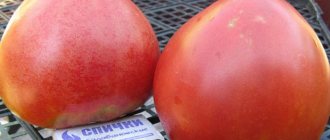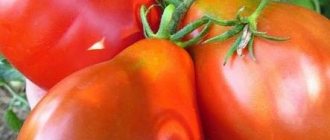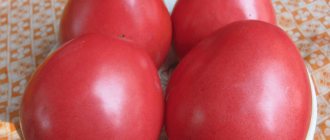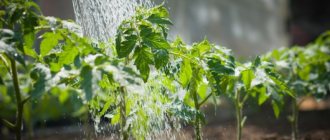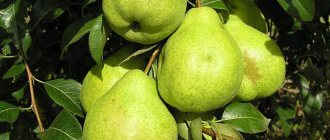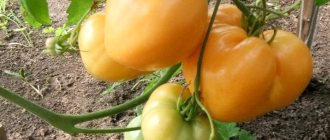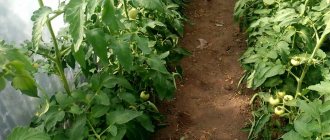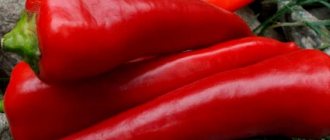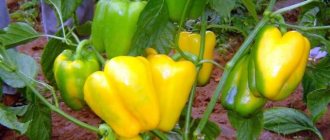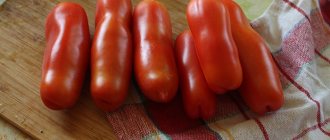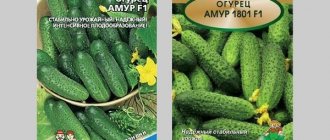What type of pear is it?
Uralochka is a late-autumn small-fruited variety. The harvest ripens by the twentieth of September , remains on the branches for a short time, up to ten days, then falls all at once. The fruits are stored satisfactorily - subject to the conditions - and not for long, no more than thirty days.
Autumn varieties also include Noyabrskaya, Osennyaya Yakovleva, Mramornaya, Pamyati Zhegalova and Larinskaya.
History of selection and region of breeding
The Uralochka pear variety was bred by specialists from the Southern Urals at the Research Institute of Horticulture and Potato Growing E.A. Falkerberg, L.I. Bolotova and M.A. Mazunin.
“Dad and Mom” Uralochka - varieties 41-15-9 ( Ussuri pear) and Severyanka . The area of growth is mainly the Urals and Western Siberia, and can also be found in the Far East. It is grown not only by industrialists, but also by amateur gardeners.
In these regions, Uralochka, Svarog, Krasnobokaya, Pamyati Yakovlev and Tyoma pears do well.
Agricultural technology
The methods of caring for this variety completely coincide with conventional agricultural practices in cool regions. It is recommended to use Ussuri pear as a rootstock. It is imperative to form a crown and subsequently carry out thinning and sanitary pruning.
Uralochka is an example of the fact that heat-loving fruit crops can bear fruit well in the harsh conditions of the Urals and Siberia. It is considered promising for intensive cultivation. Our heroine can safely be called a reliable variety. It has high productivity, shows stable fruiting, has high winter hardiness of wood and resistance of flowers to spring return frosts. In addition, it has excellent immunity, is not affected by scab and actively resists other diseases and pests. High levels of winter hardiness contributed to the active use of the variety in breeding. During the growing period, no significant deficiencies were noted. The only disadvantage of pears is the insufficient weight of the fruit, but for cool regions this is a typical phenomenon.
Description of the Uralochka variety
Let us consider separately the appearance of the tree and the fruit.
Tree
The tree is covered with smooth gray bark and is of medium height - a maximum of 5 meters.
The angle of deviation of the branches from the trunk is almost 90 degrees. The shoot is brown, slightly geniculate, glabrous, rounded.
There are few lentils, they are small.
The leaf is also not large in size, rich green, with a wavy, finely serrated edge.
It has the shape of an ellipse, a smooth shiny surface, and is pointed at the end.
The petioles are thin, light green.
Fetus
The fruits are small - maximum 50 g, regular pear-shaped, amber in color.
The pear pulp is creamy, juicy, fine-grained, aromatic, with a sweet and sour taste and rather large brown seeds inside.
The stalk is small, slightly curved, and comes from a shallow funnel. The flower is small, pale pink.
Pros and cons of the variety
- The undoubted advantages of this variety include:
- record frost resistance;
- the ability, unlike other pear varieties, to withstand spring frosts;
- some shade tolerance, also not characteristic of most pear varieties;
- stable yield;
- good keeping quality of fruits;
- their excellent transportability;
- versatility of fruit use;
- ability to resist scab;
- low maintenance requirements.
- The disadvantages of the variety are usually listed as:
- small fruit sizes;
- falling of pears from the tree.
Photo
Characteristics
Uralochka is not afraid of frosts, evening cold, or spring frosts.
Slightly less resistant to gall mite attacks. Uralochka is well pollinated.
The best pollinators of the Uralochka pear variety are Vekovaya and Povislaya .
Parthenocarpic fruit may often be set. It begins to bear fruit in the fourth year and immediately shows its fertility.
The seven-year-old Uralochka pear produces up to 40 kg of yield per tree . Frost resistance - down to minus 45-48 degrees Celsius .
The pear is “propagated” by the scion of the Ussuri pear and by budding.
It needs pruning at a young age - for formative purposes, and for rejuvenating purposes - for an adult tree. Doesn't like drought.
The following pear varieties have good frost resistance: Duchess, Yakovlevskaya, Feeriya, Tonkovetka and Quiet Don.
Pear for the Urals: the best varieties
The Urals are characterized by unique weather and climatic conditions that must be taken into account when cultivating pears. Under these conditions, the role of the variety, which must be adapted to the local climate and combine winter hardiness, disease resistance and high productivity, especially increases. That is why you should find out in advance which pear to plant in the Urals and how to grow it correctly.
Pear for the Urals: the best varieties
Berezhenaya (Bere yellow improved)
The variety was obtained by mutation of cuttings of another species Bere yellow, carried out in laboratory conditions. The main characteristic that substantiates the prospects of this variety for the Urals is the very high winter hardiness of both wood and flower buds. The tree is low-growing, with a rounded crown. The branches are strong and strong, growing at an angle and extended upward.
The weight of the fruit is average for this crop, about 110 g. The shape of the fruit is ovoid, regular, with a smooth and even skin. The main color of the fruit is light yellow, there is no cover color.
The fruit pulp is relatively dense and cream-colored. Its characteristics include oiliness and juiciness. It has a sweet and sour taste and a delicate pleasant aroma.
Berezhenaya (Bere yellow improved)
The tree begins to bear fruit in the 5th year of cultivation and immediately produces a large and high-quality harvest. Fruiting occurs regularly; shedding of ripened fruits is not observed. Pears have high commercial qualities and can be transported over long distances. With proper organization, the fruits can be stored for up to 3-4 months. The variety is resistant to major pear diseases and pests, and is also versatile and suitable for various types of technical processing. Its disadvantages include the need for a pollinator and low drought tolerance.
Dobryanka (Sentyabrina)
Obtained as a result of targeted crossing of form 2-39 and the Pervenets pear variety. The trees are medium-sized, grow quite quickly and begin to produce a harvest in 4-5 years. The crown is pyramidal in shape, persistent and strong, with medium foliage. The branches are strong, growing from the trunk at an obtuse angle.
Ripe fruits have an average weight of 160 g, the maximum weight reaches 190 g. The fruits are pear- or lemon-shaped with a widening in the middle part. The peel is smooth, dry, and has a dull appearance. The color is rich green, eventually turning yellowish-green with the presence of brownish-reddish stripes along the surface of the fruit.
The pulp is medium-dense with a yellowish color, without the presence of stony fiber. This ensures the taste of the fruit. The harvest is high, formed annually and in the medium term, without crumbling. Fruits can be transported over long distances.
Any pear pollinators are suitable for this variety.
Important! All parts of the tree, including flowers, tolerate low winter and spring temperatures.
The variety is also resistant to scab, mononucleosis and parasites. The main disadvantage of September is the short (no more than a month) storage period for the fruit.
Talitsa (Skorospelka Sverdlovskaya)
The Talitsa pear is the result of hybridization of the Bere yellow and Early summer pear varieties. The tree grows very quickly and reaches significant size in a short period. It has a pyramidal crown with spreading, not very strong branches. With good fruiting, the stems may bend under the weight of the fruit.
The harvest ripens in the second ten days of August. The fruits are usually small, maximum weight 110 g. The peel is smooth, with roughness. The color is yellowish, and large hardened marks are found on the surface of the fruit.
The pulp of the variety is creamy in color, and there is practically no stony fiber in its structure. The taste is sour-sweet with a clearly noticeable honey tint. The fruits are juicy and exude a strong, pleasant aroma.
The fruits ripen early, approximately 80 days after flowering. The variety is characterized by increased productivity: from 1 hectare it is possible to harvest up to 39 tons of fruits. Fruiting begins in 5-6 years and occurs annually. The variety is predominantly technical, recommended for use for processing.
Important! The Skorospelka Sverdlovskaya pear easily tolerates winter cold and spring frosts, and is usually not damaged by scab. At the same time, it does not have sufficient resistance to drought conditions.
A significant disadvantage of the variety is its short storage period - about 1.5 weeks. As the fruits ripen, they begin to fall off en masse. The variety is not suitable for transportation and therefore is almost not sold. Talitsa is a self-sterile variety, but can be pollinated by other varieties, with the exception of the Ussuri pear, which does not coincide with it in terms of flowering.
Compact (Zarechnaya)
Zarechnaya pear is the result of targeted hybridization of the Tema and Rannyaya Milevskaya varieties. Trees are characterized by accelerated growth, but their size is relatively small. In the first years, the crown has a spherical shape; over time, as a result of abundant fruiting, it spreads slightly in different directions. It stands out for its excessive thickening.
The compact plant begins to bear fruit 5-6 years after planting. The fruits have an average weight of 115 g, maximum weight is about 140 g. The shape is typical of a pear. The peel is smooth, thin. The fruits are golden-yellowish in color, with a slight orange blush.
According to the description of the Zarechnaya pear, the flesh is medium-dense, has a fine-grained structure, and is soft. The taste is sweet, without sour shades, with a creamy color. Ripe fruits have good commercial properties and do not fall off. The fruits are usually stored for one month.
Sverdlovsk resident
The variety was obtained as a result of pollination of the Lukashovka pear with a mixture of pollen of several species from the southern regions of Russia. The trees are medium-sized, with a rounded, wide-pyramidal crown.
The shape of the fruit is slightly longer than usual for pears, its weight reaches 180 g. The peel is smooth, has a green color on the tree, and as it ripens after picking, it changes color to yellow. When exposed to sunlight, the fruit usually develops a blush.
The pulp is juicy and oily. The color is white with faint yellowish markings. The fruits are characterized by a sweet and sour taste with a good aroma. The variety usually begins to bear fruit in the 4th year, increasing in volume every year. The average yield of the variety is 200 centners per hectare. The fruits do not fall off the tree as they ripen and can be transported over long distances. Plants are resistant to major diseases and low temperatures.
Important! As the variety moves to regions located north of the Urals, a slight decrease in winter hardiness is noted.
The variety is self-sterile. For normal cultivation, you need to grow several pollinating trees next to it.
Penguin
Trees of the variety grow up to 3-4 m and form thorns on the stems. The crown has a wide pyramidal shape and is usually thickened, which is why pruning is especially important for the variety. The fruits have a classic shape for the culture and weigh 100-130 g. Pears have a rich yellow color and a bright orange tan. The pulp is very sweet and juicy, without granulation. The fruits ripen in the last ten days of August; the harvested crop is stored for about 2 weeks. In addition to the above positive properties, the variety is characterized by winter hardiness and resistance to gall mites.
Important! Among the disadvantages of the Penguin pear, a thickened crown is usually distinguished, which, under certain conditions, can cause the spread of fungal infections.
Guidon
Trees of the variety are characterized by short stature and strong shoots. The wood is cold-resistant and is usually not damaged even by severe frosts. The fruits ripen in early September and after harvesting are stored for about 1.5 weeks. The shape of the fruit is conical, weight varies from 100 to 140 g. The skin has a yellow-greenish color. The fruit pulp is juicy and sweet, with a certain granulation content.
Pear variety Guidon
Favorite
This is a native Ural pear, obtained as a result of hybridization of the pear varieties Dekabrinka and Lesnaya Krasivitsa under the guidance of breeders E.A. Falkenberg and F. M. Gasimov. The variety produces low-growing trees with a crown of medium density and spreading.
The plants bear fruit 5 years after planting and annually form a significant harvest (up to 35 kg of fruit is harvested from 1 tree). The shape is typical for a pear, shortened. Their weight is 140-170 g. The taste is sweet, tasters rate it 4.5 points out of 5. The fruits ripen in September, after harvesting the harvest is stored for about 1-1.5 months. The cut fruits are white and juicy. In addition to high productivity and winter hardiness, the variety is characterized by resistance to a number of diseases and pests such as:
- pear mite;
- scab;
- bacterial burn.
Krasulya
The variety was obtained by crossing the species Late and Little Joy. Krasula is especially common in the southern regions of the Urals (Kurgan, Shadrinsky district, Chelyabinsk), as well as in Western Siberia.
The tree grows up to 4 m in height. The crown is rounded with thorny branches. The variety begins to bear fruit in 5-6 years. No periodicity is observed. The fruits ripen in the second ten days of August. The variety produces a rich harvest of pears in the Urals: up to 40 kg are harvested from 1 adult, fully developed tree.
The weight of the fruit is 90-120 g. Their shape is rounded, the color is very bright, greenish-yellow with a red-violet strong tan. The pulp is cream-colored, loose and tender. The taste is sweet and pleasant, rated 4.7 points by tasters. The collected fruits are stored for 1.5-2 weeks.
Krasulya belongs to the category of self-sterile varieties. Suitable for pollination:
Decabrinka
A hybrid variety, the result of targeted crossing of Forest Beauty and Limonka isikulskaya. Trees of medium vigor. The crown is rounded and prone to thickening. The fruits are small, most often their weight varies between 90-110 g. Their shape is standard for this crop, very neat. The peel of a ripe crop is deep yellow with a faint tan. There are many small subcutaneous marks on the surface of the fruit. The taste of the fruit is predominantly sweet with a touch of slight sourness. The smell is pleasant and subtle. The pulp is very juicy and slightly coarse.
Decabrinka pear variety
Important! Decabrinka begins to bear fruit 7 years after planting.
The variety is self-sterile; the Larinskaya and Uralochka species are most often used as pollinators. Productivity is high, fruiting occurs regularly. The fruits usually ripen in the second decade of September and are stored for 3 months from the date of collection. The variety is characterized by resistance to scab and pear gall mite, and tolerates unfavorable winter conditions.
Sanremi
This is a columnar winter pear variety, one of the best for the Urals. The main properties are unpretentiousness during cultivation and the formation of large fruits.
The variety ripens in the first half of October and produces pears weighing up to 400 g. The fruits have an apple-like shape: oval-round with a greenish-yellow color similar to golden. There is no blush. The pulp is juicy, very sweet and loose, and has a rich white color.
Important! The columnar plant grows up to 2 m in height, making it easy to care for and harvest.
Sanremi can self-pollinate and is resistant to clasterosporia and moniliosis. Trees should be planted at a distance of 1 m from each other.
Caring for pear trees in the Urals
The agrotechnical features of cultivating the crop in question in this region are in many ways similar to those used in the western part of Russia. So, when planting, you should choose the most fertile area, and when planting a hole, you need to dig a small ditch around the seedling, into which at least 20 liters of water are immediately poured and which will subsequently be used for irrigation.
The tree does not need frequent watering and fertilizing. These activities should only be carried out when necessary. Pruning is carried out in the spring according to the standard scheme.
Note! In the Urals, it is worth regularly carrying out sanitary pruning, getting rid of thickening branches, as well as diseased, dried out, and severely injured shoots.
When cultivating crops in these conditions, the selection of pear varieties for the Urals and well-designed agricultural technology are especially important. The combination of these two conditions will allow you to get a good quality harvest.
Planting and care
The future tree, of course, needs an “earth house”. They dig a hole under the pear tree in advance, let it stand so that it does not crumble and the seedling in it is calm. Dimensions - approximately 100x50 cm, a wooden peg is installed in the center.
If the soil is clayey, a drainage layer will be required, then a layer of nutrient soil . If it is dry, there is no need for drainage; however, phosphorus-potassium fertilizers and ash are added to the nutrient mixture of soil and humus.
The latter, in addition to its main role, also performs a disinfecting function - it is quite possible that the roots of the seedling were injured during planting. The nutrient soil must be thoroughly mixed. If this is not done, you can burn the roots with chemicals.
The hole is filled one-third full, the nutrient soil is laid in a mound, and a seedling is placed on this mound. It should be filled in so that the root collar is at least 3-6 centimeters above ground level.
The roots should be straightened. The seedling is tied to a wooden stake installed in a hole.
Having planted a pear, you need to water it well, and trample the ground around it with your foot. Make an earthen rim around the hole.
The seedling is very defenseless; it needs to be protected from burns, cold, and rodents. In the first years of its life, it is good to bury the tree in the snow.
It is necessary to feed the pear when it begins to bear fruit.
Diseases and pests
Despite the fact that Uralochka is a strong “girl,” she still needs protection. One of the most terrible misfortunes of pears is the so-called “Antonov fire”, also known as Black cancer. To protect yourself from it, you need to collect and burn fallen leaves in a timely manner, preventing bacteria from multiplying.
If you notice that the tree is sick, the affected areas should be cut off with a sharp knife, including healthy tissue. Wounds should be disinfected with copper sulfate or covered with a mixture of clay and mullein.
Another scourge is maniliosis. They fight it by spraying the shoots with Bordeaux mixture or a solution of copper chloride. The timely removal of fallen trees and fallen leaves should not be neglected.
rust is also dangerous for Uralochka . Against it, the tree in spring and autumn, after the leaves have fallen, is sprayed with Bordeaux mixture or sulfur.
leaf rollers and gall mites - will also make themselves known They can be controlled by spraying the shoots with chemicals such as Cymbush or colloidal sulfur.
The following varieties can boast of good disease resistance: Cathedralnaya, Krasulya, Lada, Naryadnaya Efimova and Otradnenskaya.
Characteristics and description of carrot variety Nantes 4, cultivation and care
Uralochka will become a real treasure even for a novice gardener. There is nothing complicated about planting or caring for it; you just need to follow a number of simple rules.
A tree, like any child, needs care and careful protection, without which it will wither.
But with all this simplicity of technology, you need to remember that diseases cannot be started - they develop very quickly, and parasites will just as quickly destroy the tree if you give them free rein.
